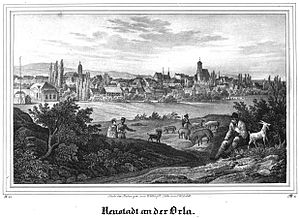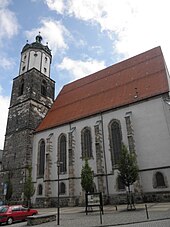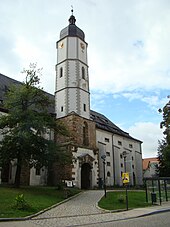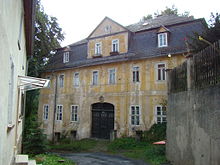Neustadt an der Orla
| coat of arms | Germany map | |
|---|---|---|
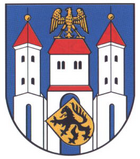
|
Coordinates: 50 ° 44 ' N , 11 ° 45' E |
|
| Basic data | ||
| State : | Thuringia | |
| County : | Saale-Orla district | |
| Fulfilling municipality : | for Kospoda | |
| Height : | 300 m above sea level NHN | |
| Area : | 86.08 km 2 | |
| Residents: | 9198 (Dec. 31, 2019) | |
| Population density : | 107 inhabitants per km 2 | |
| Postal code : | 07806 | |
| Primaries : | 036481 and 036484 for the districts Dreba and Knau | |
| License plate : | SOK, LBS, PN, SCZ | |
| Community key : | 16 0 75 073 | |
| City structure: | 12 districts | |
City administration address : |
Markt 1 07806 Neustadt an der Orla |
|
| Website : | ||
| Mayor : | Ralf Weisse (Alliance for Neustadt) | |
| Location of the city of Neustadt an der Orla in the Saale-Orla district | ||
Neustadt an der Orla is a small town in the Saale-Orla district in eastern Thuringia .
geography
Geographical location
The addition of the Orla , which distinguishes it from other new towns, refers to the Orla river . It rises east of Triptis , initially flows about 20 kilometers in a westerly direction and changes it to the north at Pößneck, 13 km to the west . After another 15 kilometers, the Orla joins the Saale at Orlamünde . Both rivers give the Saale-Orla district its name. The river Orla and the gently rounded table mountains characterize the Orlasenke , the scenic area in which Neustadt an der Orla nestles. The Thuringian woodland extends north of the city .
Neighboring communities
Neighboring communities are (clockwise) Meusebach , Bremsnitz , Triptis , Rosendorf , Dreitzsch , Schmieritz , Lemnitz , Tömmelsdorf , Moßbach , Dittersdorf , Plothen , Volkmannsdorf , Schöndorf , Keila , Peuchen , Grobengereuth , Oberoppurg , Quaschwitz , Weira , Kospoda , Lausnitz , Langenorla , Trockenborn-Wolfersdorf .
City structure
| District | surface | First documentary mention |
|---|---|---|
| Neustadt an der Orla | 12.53 km² | April 16, 1120 |
| Arnshaugk | 0.24 km² | March 20, 1252 |
| Breitenhain-Strößwitz | 5.57 km² | June 1, 1320 |
| Börthen | 1.26 km² | 1378 |
| Dreba | 12.47 km² | 1320 |
| Knau with Posen and Bucha | 15.92 km² | 1374 |
| Lichtenau | 2.25 km² | 1423 |
| Linda with stone bridges , Köthnitz and Kleina | 16.66 km² | 1378 |
| Moder joke | 5.59 km² | April 16, 1120 |
| Molbitz with Döhlen | 4.55 km² | 1350 |
| Neunhofen | 4.54 km² | 1071 |
| Stanau | 4.28 km² | 1071 |
| total | 86.07 km² |
history
Around 1000, Arnshaugk Castle was built in what is now Neustadt an der Orla on the site of an older prehistoric complex. In 1120 Nova villa , a place of German foundation, was mentioned in a deed of donation from the Thuringian Count Wichmann to the Kaltenborn monastery. In the period between 1150 and 1250 the city of Neustadt was founded by the Lords of Lobdeburg . The city was first mentioned in a document in 1287.
In 1325 there were already city walls in Neustadt . The “Stone House” was given to the city in 1364 as the town hall by Landgrave Balthasar. The city freed itself from the mother church of Neunhofen in 1400 by building its own parish church. The new town hall, including the “stone house”, took place in 1465.
The Neustädter Kreis was formed in 1485. From 1471 to 1490 the Augustinian monastery and church were rebuilt. The St. John's Church received its new altar from the workshop of Lucas Cranach the Elder in 1513. Martin Luther visited the city several times, in 1516 and 1524.
From 1621 to 1622 there was a mint in the city where, under the mint masters Hans Treuttner and Christoph Kraft, interim coins (kipper coins) ranging from groschen to so-called Kippertaler to 60 groschen were struck.
The city's castle was built after 1674 by Duke Moritz von Sachsen-Zeitz . Neustadt got its first post office on the Leipzig-Nuremberg post line in 1708 . By order of Augustus the Strong , two post-distance columns from Electoral Saxony were erected in front of the Triptiser and Neunhöfer Tor in the city in 1728 .
In 1815 Neustadt an der Orla came to the Grand Duchy of Saxony-Weimar-Eisenach together with a large part of the Neustädter Kreis as part of a resolution by the Congress of Vienna . The Neustädter Sparkasse was founded in 1823, the municipal hospital on Eiskellerplatz was opened on December 24, 1851. Neustadt received its first rail link with the opening of the Leipzig – Probstzella railway on December 20, 1871. In 1922 the city became part of the Gera district .
On April 9 and 10, 1945 Neustadt was the target of US bombing raids . 28 deaths were to be mourned. On April 14, 1945, the American occupation forces marched into Neustadt. The Red Army took over on July 1 of that year.
With the formation of the Pößneck district in 1952 from parts of the previous districts of Gera, Saalfeld and Ziegenrück, Neustadt was added to this. The first demonstrations took place in Neustadt an der Orla on October 26, 1989 during the fall of the Wall . The first free local elections took place on May 6, 1990.
In the course of the district reform in 1994 Neustadt came to the Saale-Orla district .
Incorporations
The first incorporation took place with Moderwitz on July 1, 1950. Molbitz was incorporated into Neustadt an der Orla on January 1, 1976.
Lichtenau with about 200 inhabitants is located northwest of Neustadt an der Orla. The first documentary mention was in 1364. The church was built in 1730 using an older system. Lichtenau was incorporated into Neustadt an der Orla on April 9, 1994. At the same time Neunhofen was incorporated.
On December 1, 2010, the municipality of Breitenhain was incorporated. Stanau has also been part of Neustadt an der Orla since January 1, 2019 . On December 31, 2019 the communities Dreba , Knau and Linda were incorporated into the city.
Population development
Development of the population (from 1981: as of December 31) :
|
1830 to 1950
|
1981 to 1998
|
1999 to 2005
|
2006 to 2012
|
2013 to 2019
|
- Data source from 1994: Thuringian State Office for Statistics
1: October 29th
2: August 31st
3: significant population growth due to incorporations
politics
City council
The local elections on May 26, 2019 led to the following results for the 2019-2024 legislative period :
| Party / list | Seats | +/- |
| CDU | 5 | - 1 |
| The left | 3 | - 2nd |
| SPD | 1 | - 1 |
| Alliance for Neustadt (BfN) | 7th | + 1 |
| UBV | 1 | ± 0 |
| JUN | 3 | + 3 |
coat of arms
The coat of arms of the city of Neustadt an der Orla shows 3 silver towers with red roofs on a blue background, the middle one lower and broadly roofed between two higher corner towers with pointed roofs and golden knobs. The towers are connected by battlements. On the central tower a golden eagle, at the gate a leaning golden shield with an upright black lion inside.
Town twinning
Neustadt an der Orla is a member of the largest international Neustadt working group in Europe , in which 37 cities and municipalities named Neustadt in seven European countries (Germany, Austria, Hungary, Czech Republic, Slovakia, Poland and the Netherlands) have come together. There are also partnerships with:
-
 Laupheim in Baden-Württemberg
Laupheim in Baden-Württemberg -
 Biedenkopf on the Lahn in Hesse
Biedenkopf on the Lahn in Hesse -
 Wépion-sur-Meuse (incorporated into Namur ) in Belgium
Wépion-sur-Meuse (incorporated into Namur ) in Belgium -
 Oostduinkerke-aan-Zee (incorporated into Koksijde ) in Belgium
Oostduinkerke-aan-Zee (incorporated into Koksijde ) in Belgium -
 La Charité-sur-Loire in France
La Charité-sur-Loire in France
Culture and sights
Historic Buildings
- The most important building on the market is the late Gothic town hall with its rich stone carvings. Since 1464, two parts of the building were combined, the eastern, slightly higher building (up until then already used as the town hall) and the western part (the so-called town hall chapel) to form the magnificent building. Also noteworthy are the door and window frames and the artistically crafted gables on the east and south sides. To the right of the outside staircase, the stone toad hangs over a pointed arched door, sitting on a loaf of bread. Behind this entrance gate there is a council scale from 1597 in the former passage from the street to the market.
- Meat banks
- In a passage from the market to the church square you will find the meat banks , a medieval butcher shop. Of the former seventeen sales arbors that were arranged on both sides, nine have survived. This certificate of folklore from 1475 is unique in Europe and was renovated in 2002. The facility was created more than five hundred years ago so that the butchers were only allowed to sell meat there and under the supervision of a meat overseer appointed by the council. It was strictly monitored that the prices were not undercut or exceeded, that the hygienic regulations were observed and that the quality of the meat met the requirements.
- Luther House
- The largest town house on the market is the Luther House . Martin Luther is said to have lived in the building, which basically dates back to at least the 15th century, during his stays in Neustadt. At least that's how it was spread by the city in the 1930s to attract visitors. As far as we know today, Luther stayed in Neustadt, but there is no evidence of a stay in the Lutherhaus. With its steep roof and beautiful bay window, the Lutherhaus visually dominates the east side of the market. The old post office with the magnificent entrance portal is a few houses further in the direction of the main road.
- Monastery church and castle
- The monastery church, also known as the castle church, is the only remaining remnant of the Augustinian hermit monastery that was destroyed in the Thirty Years War and emerged from its monastery church. The gate passage separating the nave was laid out in 1674 with the construction of a castle for the Dukes of Saxony-Zeitz in the southern part of the site. The city park begins next to the monastery church and is adorned with a Hercules fountain. The path leads along the old city wall to the rest of a defense tower. The adjacent city park emerged from the former monastery garden.
- City Church of St. Johannis
- The town church of St. Johannis was built between 1471 and 1528. The interior is decorated with an altarpiece from the workshop of Lucas Cranach the Elder. Ä. It is the only Cranach altar that has remained unchanged in its original location. There is also an organ by Johann Georg Fincke (1726). The second largest bell in Thuringia, "Susanna", which was cast on the market square in 1479, is part of the bell ringing.
- Hospital Church of St. Laurentius
- In the old cemetery stands the St. Laurentius Hospital Church , which goes back to a mess chapel mentioned in the 15th century. It received its present form mainly through structural measures in the 18th century. Numerous historical tombs have been erected on its outer walls.
- Post mile pillars
- The faithful replicas of the two Saxon post mile columns from the Triptiser Tor (original base in front of the museum) and Neunhofer Tor enhance the city center.
- Bismarck Tower
- The 32.65 m high Bismarck tower was inaugurated on the Kesselberg north of the city in 1915 . At times it was named "Adolf Elle Tower" after its builder. In 1991 the tower was completely renovated and is now a popular excursion destination. From the top of the tower the visitor has a good view of the Orlasenke .
- Arnshaugk
- The Arnshaugk district is rich in historical buildings. In addition to the chapel donated in 1249 and the old courtyard structure, the New Palace is also important.
- Church in Neunhofen
- The restoration of the towering church, which originally dates back to the 12th century, was funded by the German Foundation for Monument Protection . In the surrounding churchyard is the hereditary burial of the von Wurmb-Lausnitz family. The staircase is decorated with a sculpture of Richeza , who is considered the founder of the church.
- There is a pigeon tower in the Neunhofen mill.
Regular events
- carnival
- The "Four Great Days" of the carnival take place every year, the highlight of which in Duhlendorf, as Neustadt is jokingly called at the time, is the carnival parade with countless floats, foot groups and music bands through the city center of Neustadt, which always starts at 2 p.m. Rose Monday begins.
- Fountain festival BORNQUAS
- An old fountain cleaning festival whose origins go back to the 15th century. It is celebrated every year on the third weekend in June.
- Neustädter Musiksommer
- Advent market
Sports
- Two of the largest clubs are the soccer club SV Blau-Weiß 90 Neustadt (Orla) and the gymnastics club TSV Germania 1887 Neustadt an der Orla. SV Blau-Weiß 90 Neustadt an der Orla has been playing in the highest Thuringian league, the Thuringian League, since the 2010/2011 season .
- Another sports club is the 1st Billard Club Neustadt an der Orla 1997 e. V. , which is one of the most successful East German billiards clubs and has the multiple German champion Bernd Schneider in its ranks. The 1st BC is the reigning Thuringian champion (league and cup) and has played in the Bundesliga (all-around) in carom billiards since the 1999/2000 season .
- Another noteworthy association is KSV Germania 1990 Neustadt an der Orla. In the 2012/2013 season with a women's team in the 3rd Bundesliga and two men's teams and one women's team in the regional league, it is one of the most successful bowling clubs in the district. In the 2014/15 season, the club was able to provide 2 members of the district team, who became the 2nd German youth champion.
Economy and Infrastructure
Established businesses
672 businesses are registered for Neustadt an der Orla. (As of April 18, 2016)
education
- State Orlatal High School
- State regular school "Johann Wolfgang von Goethe"
- State primary school "Friedrich Schiller"
- Castle school of the Arbeiterwohlfahrt (comprehensive school)
- State primary school Neunhofen
- State Primary School Knau / Primary School at the Rittergut
media
The "Neustädter Kreisbote" is the official gazette of the city of Neustadt an der Orla, which appears every fortnight.
The film Nova Villa , a film about the development and the present of the city of Neustadt an der Orla, which was released in 2006 , offers an interesting overview and can be purchased in the culture and tourism office of the city administration Neustadt an der Orla.
traffic
To the east, Triptis, eight kilometers away, is the next larger city with its own motorway exit ( A 9 ). There is another connection to this motorway via the junction Dittersdorf , ten kilometers south of Neustadt. The federal highway 281 has been expanded into an expressway since 2000, which leads past Neustadt to the south as a bypass. It offers three departures into the city. Regional roads also lead via Stadtroda to Jena and Schleiz .
There has been a connection to the rail network since 1871, initially on the Gera – Neustadt – Eichicht line . Today, a regional train line EB 33 and a regional express line EBx12 run on the Leipzig – Gera – Neustadt – Saalfeld route every hour . This provides a direct connection to the ICE - node station Leipzig .
There are several regional bus connections from the bus station, including to Jena, Schleiz and Zeulenroda.
Personalities
sons and daughters of the town
- Konrad Limmer (1522–1592), theologian and reformer
- Joseph Clauder (1586–1653), Protestant theologian, hymn composer and poet
- Johann Paul Hebenstreit (1664–1718), moral philosopher and Lutheran theologian
- Johann Ernst Hebenstreit (1703–1757), physician
- Christian Traugott Fleischmann (1776–1813), organist and flautist, Thomas organist in Leipzig
- Maximilian von Schreibershofen (1785–1881), Saxon infantry general, adjutant general to King Friedrich August II and member of the German Federal Military Inspection Commission
- Carl Töldte (1801 – unknown), theater director
- Hermann Hering (1821–1887), member of the Reichstag and Landtag
- Theodor Leberecht Steingräber (1830–1904), music publisher
- Friedrich Gumpert (1841–1906), horn player and music professor
- Karl Kolesch (1860–1921), teacher and geologist
- Eduard Richard Fritzsche (1860–1923), cloth factory owner, honorary citizen of the city
- Johannes Walther (1860–1937), geologist
- Martha Abicht (1878–1941), kindergarten teacher
- Edgar Pröbster (1879–1942), diplomat, orientalist and university professor
- Hans Fitz (1891–1972), playwright, actor and director
- Robert Döpel (1895–1982), nuclear physicist and professor
- Heinrich-Rudolf Ulbricht (* 1910), painter, represented in the Museum of City History - Heimatmuseum Neustadt
- Wolfgang Hempel (1927-2004), sports journalist
- Horst Hähnel (* 1932), GDR diplomat, vice consul and consul general in Egypt (1960–1963) and Iraq (1967–1971), deputy ambassador to Nigeria (1976–1978), ambassador to Ghana, Liberia and Togo (1978– 1981)
- Hartmut Rötting (1932–2015), historian and archaeologist
- Harald Fritzsche (1937–2008), football goalkeeper
- Erwin Kaldarasch (* 1940), national handball player of the GDR and handball trainer
- Barbara Junge (* 1943), documentary film director
- Franklin Kopitzsch (* 1947), politician (SPD)
- Wilfried Poßner (* 1949), politician (SED)
- Birgit Pohl (* 1954), disabled athlete
- Dietmar Schauerhammer (* 1955), bobsledder
- Laila Stieler (* 1965), screenwriter
Other personalities
- Caspar Güttel (1471–1542), theologian and reformer, lived in the monastery of the Augustinian order in Neustadt
- Christoph Irenäus (1522–1595), theologian and reformer, temporarily superintendent of Neustadt
- Matthäus Ackermann (1544–1606), locks of the Arnshaugk office
- Nikolaus Börner (1693–1760), physician
- Johann Gottfried am Ende (1752–1821), Protestant theologian
- Heinrich Ferdinand Säuberlich (1808–1885), baccalaureus, teacher and member of the state parliament
- Karl Friedrich Ferdinand Reussner (1813–1895), Grand Duke. Superintendent, pastor and councilor
- Hugo Erdmann Müller (1817–1899),, district director of the administrative district
- Emil Theodor Brüger (1827–1900), Mayor of Neustadt an der Orla, Member of the Weimar State Parliament, Privy Councilor of State
- Ottmar von Mohl (1846–1922), diplomat, died in Arnshaugk Castle near Neustadt
- Armin Trübiger (1847–1933), general practitioner and medical adviser, honorary citizen of the city
- Heinrich Kiefer (1911–1980), painter and graphic artist, lived in Neustadt for a long time
- Peter Tanz (1938–2012), pastor
- Hanka Kupfernagel (* 1974), cyclist, grew up in Neustadt
- Nico Herzig (* 1983), soccer player, lived in the Molbitz district for the first few years
- Denny Herzig (* 1984), soccer player, lived in the Molbitz district for the first few years
literature
- Manfred Lange, Brit Wollschläger: Neustadt an der Orla. Pictures from yesterday and today . Vopelius, Jena 2009, ISBN 978-3-939718-16-1 , pp. 180 .
- Herbert Pfannenschmidt: "Neustädter Inventer" in: Kultur- und Heimatspiegel; Neustadt ad Orla in words and pictures (V / 15 / 17–1956?) .
Web links
Individual evidence
- ^ Population of the municipalities from the Thuringian State Office for Statistics ( help on this ).
- ^ Wolfgang Kahl : First mention of Thuringian towns and villages. Verlag Rockstuhl, Bad Langensalza 2010, ISBN 978-3-86777-202-0 , pp. 197, 19, 41, 38, 164, 183, 183, 196.
- ^ Günter Sagan: East Thuringia in the bombing war 1939-1945 . Michael-Imhof-Verlag, Petersberg 2013. pp. 180-181. ISBN 978-3-86568-636-7
- ↑ Federal Statistical Office (Ed.): Municipalities 1994 and their changes since 01.01.1948 in the new federal states . Metzler-Poeschel, Stuttgart 1995, ISBN 3-8246-0321-7 .
- ↑ StBA: Changes in the municipalities in Germany, see 1994
- ↑ StBA: Area changes from January 01 to December 31, 2010
- ↑ Thuringian Law and Ordinance Gazette No. 11/2019 of October 18, 2019, p. 385 ff. , Accessed on January 3, 2020
- ^ Thuringian State Office for Statistics, 2019 municipal council elections in Thuringia - final result for Neustadt an der Orla
- ↑ http://www.kirchgemeinde-neustadt-orla.de/index.php?option=com_content&view=article&id=47&Itemid=58
- ↑ Werner Greiling: The Bismarck Tower. Civic engagement and national monument culture. Weimar / Jena: Hain 2003, 133 pp. ISBN 3-89807-045-X
- ↑ Biography Carl Töldte in German Stage Almanac Volume 37 1873 at Google Books
- ↑ Dietmar Eisold , Lexicon Artists in the GDR , Berlin, 2010, p. 972




